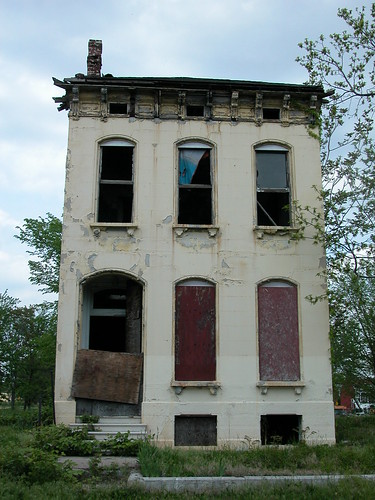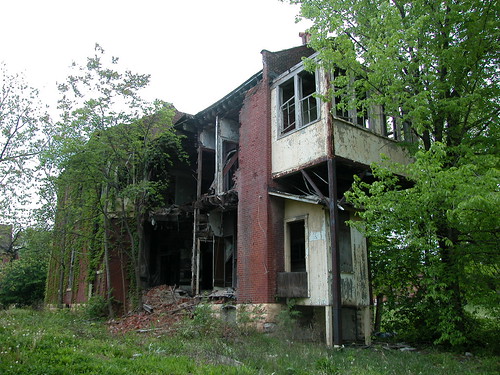 Brick rustlers have returned to the lovely stone-faced house at 1930-6 St. Louis Avenue (see ""Who Would Destroy This Building?", January 7, 2007). Most recently a funeral home, the house was first built in 1873 by wholesale grocery merchant Bernhard Winkelmann. Winkelmann was one of the numerous new-money German-Americans whose lavish homes gave St. Louis Avenue the nickname "Millionaire's Row." Today, a different millionaire owns the property: developer Paul J. McKee, Jr. through holding company N & G Ventures.
Brick rustlers have returned to the lovely stone-faced house at 1930-6 St. Louis Avenue (see ""Who Would Destroy This Building?", January 7, 2007). Most recently a funeral home, the house was first built in 1873 by wholesale grocery merchant Bernhard Winkelmann. Winkelmann was one of the numerous new-money German-Americans whose lavish homes gave St. Louis Avenue the nickname "Millionaire's Row." Today, a different millionaire owns the property: developer Paul J. McKee, Jr. through holding company N & G Ventures. The damage from 2007 concerned only a one-story flat-roofed addition behind the home, but this week's damage concerns the side wall of part of the house. Since joists run laterally and rest in the brick side walls of most 19th century buildings, this damage will eventually cause collapse of the roof and floors. However, the thieves have only struck an addition to the Winkelmann house's ell, so the original section is not yet damaged.
The damage from 2007 concerned only a one-story flat-roofed addition behind the home, but this week's damage concerns the side wall of part of the house. Since joists run laterally and rest in the brick side walls of most 19th century buildings, this damage will eventually cause collapse of the roof and floors. However, the thieves have only struck an addition to the Winkelmann house's ell, so the original section is not yet damaged.On May 21 and other occasions, McKee mentioned having a list of 60 "legacy properties" in his possession worthy of preservation. Is this house one of them? It should be. However, the list is a mystery to myself and many people in city government and the development world with whom I have discussed preservation issues related to the NorthSide project. We do know that the house at 1930 St. Louis Avenue made an official list that gives it undisputed historic status: the house is a contributing resource to the Clemens House-Columbia Brewery Historic District. It ought to be preserved, and McKee should secure it against further attack.
 Across the street is another fine stone-faced house with a lovely wooden Italianate cornice. The house at 1925 St. Louis Avenue dates to 1879 and is owned by the city's Land Reutilization Authority (LRA). The house is outside of the present historic district boundary. The front looks ragged but sturdy, but a walk around the side reveals the sad truth.
Across the street is another fine stone-faced house with a lovely wooden Italianate cornice. The house at 1925 St. Louis Avenue dates to 1879 and is owned by the city's Land Reutilization Authority (LRA). The house is outside of the present historic district boundary. The front looks ragged but sturdy, but a walk around the side reveals the sad truth. The east side wall of the ell is in shambles, although the second floor and roof are holding on for now. The condition of this house raises a preservation question related to NorthSide that has not been widely discussed: what happens to the numerous vacant historic buildings within the NorthSide footprint not owned by McEagle Properties and its subsidiaries? Most of those buildings are on the list of needed properties that McEagle submitted to the city's Tax Increment Financing Commission in May. Is the building at 1927 St. Louis Avenue one of the 60 "legacy properties"? There ar emore than 60 historic buildings owned by McEagle worthy of preservation, and at least as many in the project area owned by LRA and other entities.
The east side wall of the ell is in shambles, although the second floor and roof are holding on for now. The condition of this house raises a preservation question related to NorthSide that has not been widely discussed: what happens to the numerous vacant historic buildings within the NorthSide footprint not owned by McEagle Properties and its subsidiaries? Most of those buildings are on the list of needed properties that McEagle submitted to the city's Tax Increment Financing Commission in May. Is the building at 1927 St. Louis Avenue one of the 60 "legacy properties"? There ar emore than 60 historic buildings owned by McEagle worthy of preservation, and at least as many in the project area owned by LRA and other entities. City officials should not wait for the list of legacy properties to set into motion a sensible preservation plan for the NorthSide project. If public financing is on the table, that can be leveraged to ensure that buildings like the two above can be mothballed for eventual redevelopment in future phases of the NorthSide project.





4 comments:
McEagle and company's coining of the term "legacy properties" is a highly cynical move. No longer would they be subject to more objective determinations of historic value.
Who decides whether a building is worth saving? What makes a building a "legacy" building? Maybe the only legacy building is the Clemens House?
Yeah, maybe after he's finished with Downtown.
As a historic preservation professional, I keep waiting to learn the criteria applied to determine what a "legacy property" is. There are widely-used standards to determine what parts of multi-building developments are preserved and rehabbed, and I wonder if the developer is using them here.
Perhaps that would be a good question to ask at the northsideregeneration forum. When is that forum supposed to be on line again?
Let's all follow along closely to see what McKee/Arcturis qualify as "legacy properties". Whatever happens, indeed, this entire process is living history!
Post a Comment